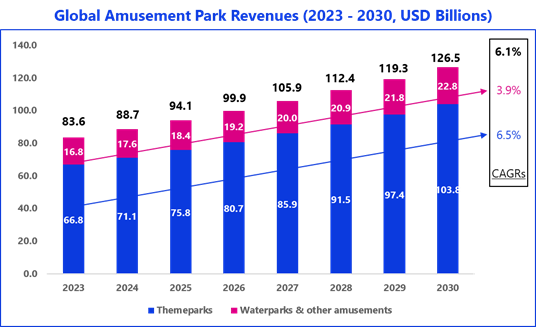The worldwide amusement park industry generated $88.7 billion in 2024 and is estimated to reach $126.5 billion by 2030 at a 6.1% CAGR. The sector experienced a significant downturn during 2020–2022 due to the pandemic but rebounded strongly, surpassing pre-COVID revenue levels in 2023. Growth in all the regions is supported by rising disposable income, expanding urban populations, and the integration of advanced payment and digital technologies that enhance operational efficiency and customer engagement.

Tickets are the primary source of revenue, and other revenue categories include food & beverages, accommodation, resort experiences, and merchandise.
The amusement park market can broadly be divided into two segments:
- Theme parks – representing around 80% of total revenues in 2023 and expected to grow at 6.5% CAGR, and
- Waterparks and other amusements, growing at a slower 3.9% CAGR.
Asia-Pacific is currently the largest region for amusement park revenues, holding a 32% share in 2023 and expected to rise to 36% by 2030.
The industry is largely dominated by two players – Walt Disney Experiences and Comcast (Universal Studios) – which together accounted for more than half of all global amusement park revenues in 2023, with only 10 resorts.

Digital Transformation and Guest Experience
Following the pandemic, the amusement park industry has accelerated its adoption of digital and immersive technologies. Attractions increasingly leverage Virtual Reality and Augmented Reality (AR) to create richer, more interactive experiences – for example, Universal’s Epic Universe Mario Kart Bowser’s Challenge combines real-world motion with AR elements to immerse guests in a hybrid digital world. Also Merlin Entertainments deployed AR in some of its parks, for example for the Legoland’s game Miniland, in which guests can use the park’s app to complete challenges.
Parks also use data analytics to personalize guest experiences, offering tailored ride recommendations, restaurant suggestions, and promotions based on previous behaviours and preferences.
Payments is now part of the experience
Payments have evolved from a transactional necessity to a strategic enabler of guest satisfaction. Visitors now expect frictionless, contactless, and instant transactions - whether purchasing tickets, food, or souvenirs. Contactless and mobile payments are now so dominant in theme parks, with some of them being cashless, that many guests question whether cash is still accepted.
To meet these expectations, theme parks are investing in omnichannel commerce, linking physical and digital environments - from online booking to in-park payments and post-visit engagement. This trend mirrors developments in hospitality and retail, where payment convenience and personalization drive customer loyalty.
Several parks have introduced Radio Frequency Identification (RFID) and wearable payment technologies to streamline transactions and reduce reliance on cash:
- Disney’s MagicBand+ allows guests to access park areas, make purchases, unlock hotel room doors, and interact with park experiences, all via a single wristband
- Universal’s TapuTapu (Volcano Bay) offers similar NFC-enabled features
- In Asia, some parks, such as Shanghai Disneyland , are piloting biometric recognition (facial or palm) for faster entry, reflecting regional trends in digital identity and authentication. Such technologies could eventually be extended to payments in the future. A similar technology, called FacePass, is already used in Abu Dhabi’s Yas Island, where visitors can authenticate with their face at the POS readers and pay
In parallel, most operators have launched dedicated mobile apps integrating payment functions, ride reservations, and live updates.
- Disney’s My Disney Experience app enables guests to link cards or mobile wallets, purchase tickets, reserve attractions, and order food
- Universal’s Virtual Line technology similarly allows digital queue management and cashless transactions
- The Merlin Entertainment Group also offers mobile apps for its theme parks, where guests can reserve rides and explore maps and ride information
These innovations not only enhance convenience but also increase average guest spending by reducing friction and promoting spontaneous purchases.
Loyalty program integration
Theme parks are increasingly introducing loyalty programs to enhance customer engagement and retention. These programs typically allow visitors to earn rewards such as free admission after accumulating a certain number of points, or special discounts on occasions like birthdays. Many are linked to co-branded credit cards - such as the Universal or Disney World reward programs with Visa, which enable guests to earn points, credits, or discounts on merchandise, food, beverages, and even exclusive experiences for every dollar spent.
In conclusion, the payment experience at theme parks is evolving in line with broader retail trends, where efficiency and speed have become essential expectations.
EDC offers a proprietary 360 payment diagnosis that helps theme park businesses identify and prioritize their pain points and identify solutions. This comprehensive approach ensures that theme parks can streamline their payment processes, enhance customer experiences, and ultimately drive revenue growth.
The content of this article does not reflect the official opinion of Edgar, Dunn & Company. The information and views expressed in this publication belong solely to the author(s).
Elisabetta is a Consultant based in London. Prior to EDC, she worked as a research fellow at SDA Bocconi University, in Milan, focusing on the analysis of entrepreneurial decision-making processes. Elisabetta holds a MSc in Economic and Social Sciences from Bocconi University in Milan and a BSc in Economics from Ca’ Foscari University of Venice. In her free time, Elisabetta loves cooking (and eating) and practicing different sports, including climbing, hiking, and swimming.
.webp)
%20(1).webp)

%20(1).webp)


.webp)

